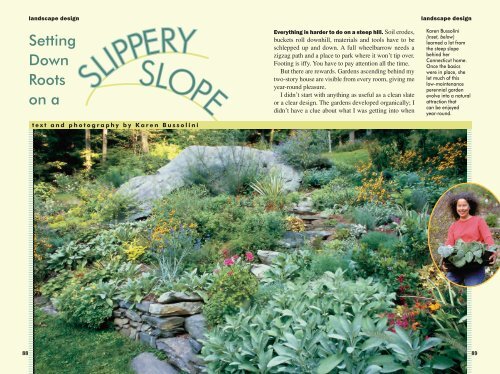SLOPE SLIPPERY - Karen Bussolini Garden Arts
SLOPE SLIPPERY - Karen Bussolini Garden Arts
SLOPE SLIPPERY - Karen Bussolini Garden Arts
You also want an ePaper? Increase the reach of your titles
YUMPU automatically turns print PDFs into web optimized ePapers that Google loves.
landscape designI first stood looking up at a deer-infested mountainside of rocks, invasivemultiflora roses, Japanese honeysuckle, and bittersweet, with a perennial inone hand and a shovel in the other.I’ve learned much to ease the way—and unlearned quite a bit of what Iknew about gardening as well.W h e r e to b e g i n ?Deer taught me to follow contours across the slope rather than workstraight up and down. Their trails became my grass paths. I wanted a wild,natural garden and figured that, since plants were already growing there(mostly tough, rhizomatous grasses and deep-rooted weeds topped by woodyinvasives), I’d just amend the soil and replace them with politer plants.Mowing grass paths was foolhardy. Even mown, they were hard to navigatewhen the grass was wet. Just as daunting, the descent was often faster thanplanned. Structures for access and secure footing—steps, terraces, and retainingwalls—were needed. These would also make it seem more like a gardenand less like a hiking trail. My initial effort involved skimpy stone steps andlow retaining walls. I called it “a garden for mountain goats.”Until plants have matured, cover all of the bare ground with mulch to help suppressweeds. Plant low-growing grasses and perennials densely. As they grow, they will fill inaround rocks, help to hold the soil in place, and retain water.The best investment I made, 15 years into it, was hiring professionals toreplace the angled grass paths with a wide, level, stone path—almost a miniterrace.They removed everything I had planted, built supports with rocksrolled downhill and crushed stone hauled uphill, laid a meandering mix ofirregular bluestone and fieldstones, regraded, and replanted. With level places,I realized that I could sit down on a chair instead of a rock. I loved havingplaces for people and places where only plants would be. With good footingand no grass to creep into beds, maintenance became 1,000 percent easier.The stone path knit together all of the little beds clustered around large rocksinto one big satisfying garden.s t e p- b y- s t e p s o l u t i o n s• Disturb the ground as little as possible. Forget double-digging: Justsmother weeds by laying down layers of newspaper, cardboard, wood chips,straw, or other organic matter. Let it sit a few months and plant right into it.• Remove loose rocks and incorporate the rest into your design. If rockslook too randomly scattered, “plant” a few more until it looks right. If yourshovel hits buried rocks,plant whatever will growover or around them. Probethe soil with a pieceof steel rebar to locatedeeper pockets of soil.Never buy a tree untilyou’ve dug a hole for itfirst.landscape designBreak up steps with paths or stepping-stones forwheelbarrow access and to help keep rainwater fromrunning down the hill.• Work with what isalready there as muchas possible and usewhat nature planted. Thelast glacier deposited ahouse-size boulder thatsplit into pieces, givingme a sheltered gardenroom and a dramatictrail of fragments spillingdownhill, which Iecho with drifts of plants.( c o n t i n u e d )90 91
landscape designOak saplings from acorns planted by asquirrel are now a grove in a place toosteep for me to have considered. Tenaciousspicebushes and ferns require nocare. If you have ledges with mosses,lowbush blueberries, or colonies ofsedges, or, in the West, salal, treasurethese survivors and plant more.• Keep water from running straightdownhill. Incorporate dips andbumps so that it can soak in. Avoidlong runs of steps, which can becomewaterfalls. Use ramps, diagonals,and contours instead. Stagger plants.Build soil dams to catch water belownew plantings or buttress them temporarilywith flat stones, boards, orlogs until plants are established.• Cover all bare ground. Coarsewood chip mulch holds soil in placeand suppresses weeds until plants fillin. Finer mulch might work well onceplants are established.• Choose low-care, deer-resistant,drought-tolerant perennial plantswith year-round presence that wantto grow in the conditions you have.There is no room for prima donnas orfussy arrangements on a slope.• Plant in layers and choose regionallyadapted, ground-covering plantsof various heights that . . .form colonies—Canada mayflower; ferns,grasses, and sedges (‘Beatlemania’,‘Ice Dance’); “no mow” grass mixesform mats—creeping sedums, dianthus,foamflower, lambs’ ears, nativeAllegheny spurge, thymehave fibrous roots—Christmas fernsself-layer or sucker, especially thicketformingshrubs—‘Nikko’ slender deutzia,‘Gro-Low’ fragrant sumac,‘Henry’s Garnet’ Virginia sweetspireself-sow—feverfew, penstemons, speciesbulbs such as snowdrops and scillaspread by stolons—creeping phlox, redosier dogwoodwedge their roots into small spaces—agaves, yuccas• See what survives and repeat yoursuccesses.<strong>Karen</strong> <strong>Bussolini</strong> is a garden photographer,writer, lecturer, and eco-friendly garden coachwhose roots are deeply sunk into a mountainsidein South Kent, Connecticut.92


